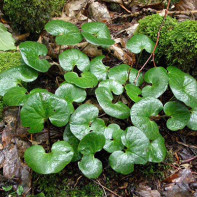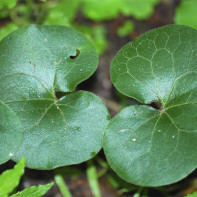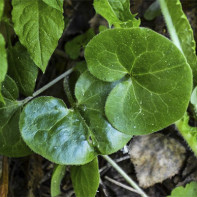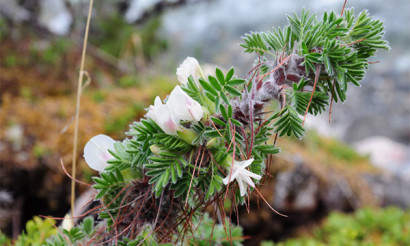Butterbur: therapeutic properties and contraindications
Since ancient times, hoofdress has been particularly popular among herbalists and healers. This perennial got its unusual name for the external resemblance of the shape of its leaves to the horse's hoof. But this is not the only nickname, which people generously endowed this medicinal plant for its magnificent properties.
- Chemical composition
- How it looks and where it grows
- Method of propagation
- Area of prevalence
- Types
- Collection and storage
- Therapeutic properties of gingerbread
- How to take hoofthorn in alcoholism
- Butterbur in traditional medicine
- Simple remedy for colds
- Remedy for improving potency in men
- Decoction for cancer patients
- Remedy for colds
- All-purpose ointment
- Laxative
- Migraine lotions
- Means for weight loss
- Collection with hoofdrops for bronchitis
- Healing compositions
- Infusion
- Tincture
- Decoction
- Contraindications for use
The crop is known by the following names: wild pepper, vomitnik, cordial, hare root, ground incense, hernivorous, striped. Reflecting the abilities of this unique representative of the flora, there is also a whole collection of unusual names. Butterbur is the only plant in our area that induces a gag reflex. This property was widely used in ancient times, if after a plentiful meal a person complained of digestive problems. Inhaling a little powder from the grinded roots of wild pepper was enough to empty an overflowing stomach.

But the ability to quickly solve gastrointestinal problems is not the only ability of the herb. Because of its rich composition, hoofgrass is included in the official directory of valuable medicinal herbs in many European countries. In Poland and Germany, it is specially cultivated for the production of certain types of medicines. Vomiting root is very actively used in folk medicine, especially to combat alcohol addiction.
Let's consider the features of this unusual representative of the plant world, as well as tell you how to properly harvest and use the herb for treatment.
Chemical composition
Almost all parts of the hoofdress can be used as medicinal raw materials. But in folk medicine, the root of the plant and the leaves are most valued. In these parts of the wild pepper, the following useful substances are concentrated:
- cardiac glycosides;
- tannins;
- organic acids;
- alkaloids (mainly azarin and its derivatives);
- starches;
- mucus in large quantities;
- essential oils;
- flavonoids;
- bitternesses;
- coumarin;
- resins;
- group of mineral elements: calcium, potassium;
- vitamins.
These substances in a single composition provide a whole complex of therapeutic properties. But at the same time it is necessary to take into account that the component azaron and its derivatives belong to the group of poisonous compounds. Therefore, with prolonged use of infusions and decoctions based on hoofdrop can be observed abnormalities of the kidneys and heart. Long-term use of herbal preparations negatively affects hematopoiesis and protein synthesis.
Important: Wild pepper is life threatening to pets, so it should be grown out of reach of pets.
What it looks like and where it grows
The hoary pepper is a member of the family Kirkazoniaceae. This evergreen plant is particularly favored by gardeners because it has a creeping branching stem that covers the ground in a beautiful living carpet. Designers often use hoofgrass to decorate recreational areas and parks. Other characteristics of the plant include:
- The rhizome of the wild pepper, like the stem, has a mass of cord-like branches.
- The height of bushes does not exceed 10-15 cm.
- The lifespan of the plant reaches 35 years or more.
- Short crawling stems end in a pair of symmetrically arranged leathery leaves.
In spring, a bell-shaped flower is formed at the top of each stem. But the flowers are no more than 10 mm in diameter, so they are lost against the background of large leaves. The flowering period of hoofthorn lasts from April to May.
Buttercup flowers have an original coloring: brownish-green on the outside and brown on the inside. During flowering, the multicolored bells exude a vanilla fragrance, which attracts ants. They are the main pollinators of the perennial.
The fruit of the plant is a hexagonal box, inside which there are microscopic seeds. Their size does not exceed 3 mm. Each box contains a huge number of such wrinkled seeds.
Propagation method
In the wild, hoofed gorse reproduces vegetatively through the separation of daughter stems. Ants also play a big role in the spread of the culture, loving to eat the seeds of the perennial and white fleshy appendages.
Gardeners use the division of the bush to expand the grass growing area. Sowing seeds is also often used for this purpose. The first shoots after sowing appear in about 3-4 weeks, but the young plants gain strength very slowly. It is only after a year that they form their first leaves.
The area of distribution
The hoary plant is one of the most widespread plants on the planet. It is native to Africa, Western Asia and North America. Nowadays, the gagweed can be found almost all over the European part of Russia, in the south of Siberia and Altai, in Belarus and Ukraine. The plant prefers humus-rich soils, but likes to stay in the shade. Therefore, it occupies the lowest tier in forests, for which reason it is often called a podlistnik. Wild pepper can be found in spruce and mixed forests, it settles in birch and aspen forests.
Species
In the botanical reference book there are descriptions of 120 species of cocksfoot. In the list of the most common species:
- The European variety is in demand in the pharmaceutical industry. On the basis of the plant are prepared anti-inflammatory and anthelmintic preparations. From the root of the European hoofed peppercorn are prepared external remedies for the treatment of wounds and scabies.
- The caudal species of wild pepper is native to North America. It is distinguished by its very large leaves and strong rhizome, which adds up to 8 cm a year. This species is very resistant to low temperatures, the plant withstands frosts down to -20°C. Tailed species is perfectly acclimatized in the middle belt. The peculiarity of this variety is active growth.
- Zibold variety is very popular among gardeners. The shrub does not have such a powerful rhizome as the ponytail species, but has a very attractive appearance: neat, rounded shrubs look great in the landscape design. The Zybold variety sheds its leaves by winter.
- Canada hoofgrass is distinguished by its beautiful burgundy-purple inflorescences. It is used only for decorative design of homestead areas.
- The shiny hoary, according to florists, is the most aesthetically effective species. Heart-shaped leaves of a deep green shade with a silvery gray pattern look impressive surrounded by small burgundy-brown flowers.
- A large species of wild pepper also has outstanding ornamental characteristics: the bright green plates of the leaves are decorated with a marble pattern.
Most of the listed varieties have found wide application in decorative gardening. The perennial is also used as a natural barrier that does not allow the spread of weeds. The dense covering of green glossy foliage of the plant not only decorates the area, but also hides its imperfections.
Gathering and storage
If you follow the rules below, it is possible to harvest valuable plant raw materials. The leaves of hoofgrass are collected during the flowering period in May, and the underground part is harvested in early spring or late fall. Many herbalists say that even the roots extracted from under the snow are suitable for medicinal use.
Rules for harvesting:
- The leaves should be carefully cut with scissors, and the roots should be dug up.
- Plant material immediately after collection should be cleaned, sorted, and well washed.
- For fast drying it is better to cut large parts into small fragments.
- Plant material can be dried outdoors in the shade or in a ventilated room. Raw material can also be dried in an oven at 50°C.
- For drying, spread the raw material in a thin layer on paper or a clean cloth.
- It is important to turn the mass regularly to prevent the appearance of mold.
When the valuable material is ready, it should be stored in a glass jar and covered with a tight lid. The shelf life of raw materials in such conditions - 1 year.
Helpful advice: when preparing hoofdress on your own, you need to follow all the recommendations. Do not forget that the herb contains a poisonous organic compound azaron, which can lead to severe poisoning and even death. When the plant is properly dried, the concentration of this dangerous component is reduced by several times.
Therapeutic properties of hoofdress

The chemical formula of the composition of the herb of hoary grass provides the plant with a whole complex of therapeutic actions. In addition to the vomiting effect, preparations based on the leaves and roots of perennial have the following effects:
- laxative;
- diuretic;
- expectorant;
- choleretic;
- soothing;
- analgesic;
- antipyretic;
- wound-healing;
- anti-inflammatory;
- anthelmintic;
- styptic;
- antispasmodic.
Scientists clinically proved that wild pepper has high anticarcinogenic activity. Also remedies, prepared according to folk recipes, prevent the appearance of sclerotic changes in the blood vessels. But the great popularity of hoary grass has found as a means for the treatment of alcoholism.
Since the plant is included in the pharmacological directory, in the pharmacy you can find phytopreparations with its participation and ready-made raw materials. For example, the herbal collection "Stopal" is very popular. In the pharmacy chain you can buy special drops for the treatment of alcohol addiction. And with neuritis and radiculitis helps tincture "Akofit", which also contains herbal components of hoof.
Note: Given the high toxicity of the plant, all methods of home treatment with the use of preparations prepared on the basis of the herb, it is necessary to coordinate with the doctor.
How to take hoofdress for alcoholism
As noted earlier, in folk and official medicine, it is mainly used in the European variety of hoofdress. The plant has gained a reputation as a powerful natural remedy against alcohol dependence.
The mechanism of action of such therapy is similar to drugs belonging to the group of alkoblockers. This means that the simultaneous reception of the herbal medicine with alcohol causes a strong gag reflex in a person. After several receptions of such a drug, the patient, suffering even from a severe form of alcoholism, develops a persistent aversion not only to the specific taste of alcoholic beverages, but even to their smell. According to the testimonies of the patients themselves and relatives of people suffering from alcohol addiction, a strong effect appears after two or three days of treatment. But of course the threshold of perception of each person will depend on the individual characteristics of his body.
Options for anti-alcohol therapy
There are several options for treating alcoholism with the use of wild pepper root. They differ in the fact that some recipes make sense to apply if the addicted person himself knows, and therefore consciously agrees to such a method of treatment. In the second case, the therapy is carried out by relatives secretly from the patient.
- To get rid of cravings for alcohol on your own, it is best to prepare a tincture on wine. To do this, mix in a 1:2 ratio pounded vomit root and the green rind of a walnut. 1 tbsp. of the resulting mixture pour 2 liters of wine. The composition should insist for two weeks. When the medicine is ready, it should be taken twice a day at 20-30 ml. The patient should know that the treatment process will be accompanied by vomiting and feelings of depression. But it is these manifestations that should make him give up alcohol.
- This option involves concealed therapy. To do this, you need to prepare a decoction of the crushed root of hoary (1 tbsp) in a glass of water. Boil the composition for 5 minutes, then let it infuse for an hour. After straining the cool decoction put in the refrigerator. Add the drug to alcohol at the rate of: 1 tbsp. per 200 ml. Full course of such treatment is 5-6 sessions. Usually after drinking alcohol with a herbal supplement, the patient has a gag reflex in a few minutes.
- This option is a little milder than the previous methods, but also causes a persistent aversion to alcoholic beverages. It is necessary to prepare an anti-alcoholic coffee drink, adding 1/4 tsp of dried root to a cup of coffee. It is very important not to overdo it, otherwise the patient may feel so bad that you will have to call an ambulance. You only need to drink such coffee once a day.
- In this case, you need to prepare special drops, after which the craving for alcohol will disappear. To this end, take in equal quantities the root of wild pepper, thyme, the herb of cougar. The components are well mixed, and then 1 tsp. of the resulting mixture to brew 50 ml of boiling water. The solution should insist a whole hour, then strain it. Usually this method is used for the secret treatment of the patient. Therefore, the medicine is added in 1-2 drops to cooked food. If there is no proper effect, the number of drops can be increased to 10, but no more.
All of the above treatments for alcoholism make sense to take only in combination with fortified alcoholic beverages. If a person drinks a simple tea with the addition of herbs, he will not have any negative feelings.
Important: you should not prepare medicinal forms of hoofdrop in large quantities. Such remedies are supposed to be kept out of reach of children.
Butterbur in folk medicine

In addition to the treatment of alcohol addiction, European hoofdrop is widely used by healers to carry out therapy for various diseases. On the basis of the leaves and roots at home, simple decoctions can be prepared, which will improve the condition in the following pathologies:
- migraines;
- edema;
- mushroom poisoning;
- heart disease;
- hepatitis;
- sexual weakness in men;
- menstrual disorders in women;
- respiratory infections;
- inflammatory processes of the respiratory tract;
- scabies;
- intestinal infestations;
- purulent wounds;
- hypotension;
- insect bites;
- neuroses;
- radiculitis;
- eye diseases;
- cystitis and nephritis.
The practice of using compositions with hoofdrop for balancing the emotional state in hysteria and epilepsy is known. Widely used medicinal plant in dermatology and the practice of treating cancer patients. Wild pepper has been shown to improve male reproductive health.
Warning! Carry out any kind of home therapy with the use of vomit should be only after agreeing with your doctor.
From this unique in its properties and composition of the healing plant, you can prepare almost any medicinal forms. For practical use, the following recipes are ideal.
A simple cure for rhinitis
The dried roots of the hoofduster should be brought to a powdered state, and then inhale it into each nasal passage. Due to the content of bactericidal components, the plant powder in a few steps will destroy pathogens, and the runny nose will disappear.
Treatment of pustules with fresh leaves is also widely used in home treatment. It is enough to apply a compress to the problem area in the form of a leaf of the plant, so that the inflammatory process quickly passed to the stage of resolution.
Means to increase potency in men
Also quite simple, but effective way to restore sexual activity. It is necessary to obtain a green porridge from the fresh leaves of the hoof, which should be mixed in equal proportions with milk. Leave the composition for a couple of hours to fully activate the components. Then apply the milk-plant mixture to the groin area in the form of a compress. Such a simple way not only normalizes potency, but also strengthens the pelvic muscles.
Decoction for cancer patients
Of course, we are not talking about complete healing in this case, but significantly improve the well-being of serious cancer patients with regular use of such decoction is possible. It is desirable to combine the use of decoction of gorse with decoction of woodruff. Take a glass of water for 1 tbsp of the herb.
Scheme of preparation:
- Grind the plant component beforehand with the help of a coffee grinder.
- Then pour water over the raw material and determine the composition in a water bath.
- After half an hour, remove the composition from the stove, cool.
Take, without straining, 1 tbsp. 4 times a day before meals. The course of this maintenance therapy - 3 months. Then you should take a break for a month, and if necessary, continue treatment again.
Cure for colds
The preparation is prepared on the basis of the root of the hoof. Only in this case, it is not necessary to grind it, but enough to divide it into small fragments. Then the plant base is brewed with steep boiling water (200 ml), put for half an hour to languish in a water bath. When the solution cools a little, strain. Take in acute colds, 10 ml 3-4 times.
Versatile ointment
This remedy will help eliminate itching from mosquito bites and inflammation, accelerate wound healing and cope with scabies. To make the ointment, you need to pluck fresh hoof leaves, chop them, knead well. Then add petroleum jelly and olive oil to the green mass. The ideal base for the ointment will be badger fat. Ready remedy to apply to problem areas of the skin several times a day.
Laxative
There are several ways to prepare a remedy that will help get rid of constipation. You can simply prepare an infusion of 1/2 tsp of wild pepper root in a glass of water. Infuse the solution for only a quarter of an hour, and then drink the entire volume at once. But beforehand, strain the infusion. After the stools have settled, cancel the treatment, so as not to cause diarrhea.
To treat coughs, take a small handful of dried hoof leaves. Then pour a liter of boiling water over the plant material. When the composition is infused, it should be taken by 1 tbsp. up to 4 times a day.
Migraine lotions
Migraine lotions relieve severe headaches in minutes. The procedure is performed as follows: the roots of the hoof must first be finely chopped, then just 1 g of raw material should be placed in a glass with boiling water. Insist the migraine medicine for exactly one hour, and after this time, soak gauze in the warm solution and apply a compress to the forehead.
Remedy for weight loss
Today there is an increased attention to any methods that help to lose a few extra pounds. In this case, a significant help can be provided by an infusion of hoary leaves, prepared according to the following formula: take 1/6 tsp of dried leaves of the healing herb for 250 ml of boiling water. Both parts combine in a bowl, and then leave to infuse for a quarter of an hour. Before use, strain the infusion. Drink the entire volume in one sitting. Against the background of such therapy, the weight will gradually begin to "melt", and after two weeks of the course will be able to lose 3-5 kg.
Collection with hoofdrop from bronchitis
This option is also widespread in home treatment. The medicine is especially effective for prolonged forms of bronchitis. For a complex composition, in addition to the leaves of hoofthorn, you will need to take more:
- fruits of fennel;
- sage;
- primrose herb;
- chicory roots;
- angelica;
- chamomile;
- sweet clover;
- blueberry herb.
Take all the herbal ingredients in equal proportions. Combine the components and mix thoroughly. After that, just 10 grams of herbal mixture to brew 0.4 liters of boiling water. The composition should infuse well. After straining, drink with a cough up to 3 times a day. A single dose of the drug is 1/4 cup. The treatment should continue until the complete disappearance of symptoms of the disease.
Here you can give a lot of other unique recipes. All herbal treatments are easy to apply. For example, a tincture of fresh leaves in vinegar can treat scabies, and wiping the eyes with a simple decoction will help get rid of conjunctivitis.
Types of healing compositions
The most common form of application of the root of hoofdrop is a powder. On its basis, ointments, decoctions, tinctures are prepared. Liquid dosage forms are intended mainly for internal reception, but concentrated solutions are used for external procedures: rubbing, compresses, treatment of open wounds. Methods for preparing such medicines are simple, so they can easily be made at home. As an example, here are classic recipes for the preparation of liquid dosage forms.

Infusion .
For daily use is sufficient to take 2 tsp. powder of wild pepper grass. Pour the herbal raw materials in a thermos, pour a glass of boiling water, close the container tightly cork. Leave the infusion for an hour. Take 1-2 tbsp. before meals. The frequency of intake depends on the nature of the disease, but it should not exceed 4 times.
Tincture
According to the traditional recipe, an aqueous tincture is prepared from dried or fresh leaves of the herb with the addition of walnut shells.
The algorithm for preparing a healing solution:
- Grind the plant parts, mix them.
- Pour the green mass with boiling water (2 liters).
- When the solution cools, pour into a jar, cover with a tight lid.
- After two weeks of infusion, the tincture from drinking will be ready for use.
- Drink one glass at a time before a meal.
Decoction
In the practice of folk medicine, decoction from the ground and root parts of the plant is equally often used.
Decoction from the dried leaves of hoofdrops is prepared in the following sequence:
- In a glass of boiling water, pour 1 tbsp. with a handful of raw materials.
- Put the composition on a water bath.
- Tolerate the decoction for 1/2 hour over extremely low heat.
- When the remedy reaches readiness, supplement the volume of liquid to the original level.
Take the medicine by 1/2 tsp. for diarrhea, gastrointestinal disorders.
Note: The solution prepared in this way is suitable for lotions for inflammatory processes of the eyes and eczema.
Attention: Take a decoction prepared according to this recipe should be taken with great caution, not allowing the specified dosages to be exceeded.
Decoction from the roots is prepared according to a similar scheme. But such a medicine is recommended for women with painful periods and intestinal disorders. A single dose of the medicine - 2 tbsp.
Contraindications to use
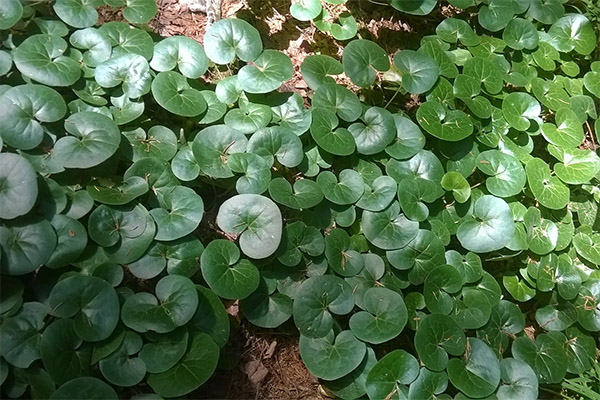
From the characteristics described at the very beginning, it is clear that hoofdress by nature is a very complex plant. Saturated with nutrient components, the composition has great health benefits, but at the same time, the toxic elements, which are also present, if not handled correctly, can cause harm. Therefore, there is quite an impressive list of contraindications to the use of drugs from any part of the wild pepper. It is categorically forbidden to carry out such therapy:
- During pregnancy and lactation;
- Patients after 65 years of age;
- Patients with hypertension;
- Children and adolescents;
- People with gastrointestinal diseases;
- People prone to allergies;
- Patients with heart failure;
- at kidney abnormalities
- During menstruation;
- In any type of bleeding.
It is also contraindicated to use any dosage form to treat people with signs of physical exhaustion. It is categorically forbidden to independently increase the dosage recommended by the prescription.
In conclusion, we would like to remind you once again that in herbs there is a great potential. Their healing power is able to put on the feet of hopeless patients. But improper handling of any herb can lead to the opposite effect. The herb hoofthorn has served humans for centuries. Even today it heals from various diseases. But it is necessary to treat this plant with respect, not forgetting about its toxic properties.
«Important: All information on this site is provided for informational purposes only. information on this site is for informational purposes only. Before applying any recommendations, you should consult with a specialist. health care professionals before you use any of the recommendations. Neither the editors nor the authors shall be liable for any possible harm caused by materials."


